University Healthcare: Discharge and Care Plan for Jim and Amara
VerifiedAdded on 2020/05/28
|11
|2718
|121
Report
AI Summary
This report presents a comprehensive discharge and care plan for Jim and his wife, Amara, addressing their specific health challenges, including Jim's fragile physical condition, Amara's COPD and heart failure. The plan emphasizes the need for professional caregivers while upholding patient autonomy, dignity, and cultural competency. It covers essential aspects such as managing hypotension, addressing CVC site infection, and providing psychosocial counseling. Ethical and legal considerations, including informed consent and beneficence, are thoroughly examined. The report underscores the importance of culturally sensitive care, considering Jim and Amara's Greek background and preferences. The report provides a detailed plan for their care, including caregiver support, medication management, and follow-up appointments, aiming to improve their quality of life while respecting their wishes to remain at home.
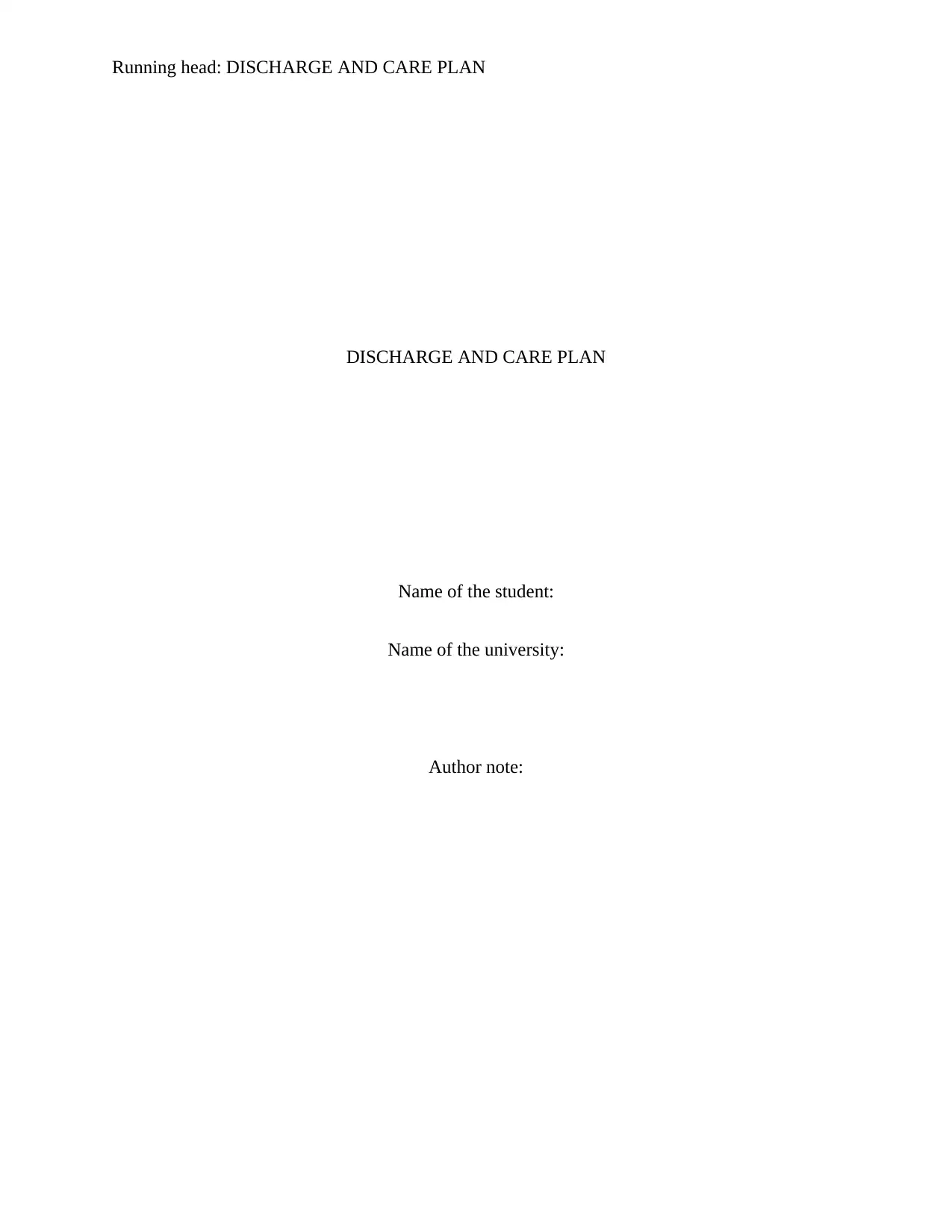
Running head: DISCHARGE AND CARE PLAN
DISCHARGE AND CARE PLAN
Name of the student:
Name of the university:
Author note:
DISCHARGE AND CARE PLAN
Name of the student:
Name of the university:
Author note:
Paraphrase This Document
Need a fresh take? Get an instant paraphrase of this document with our AI Paraphraser
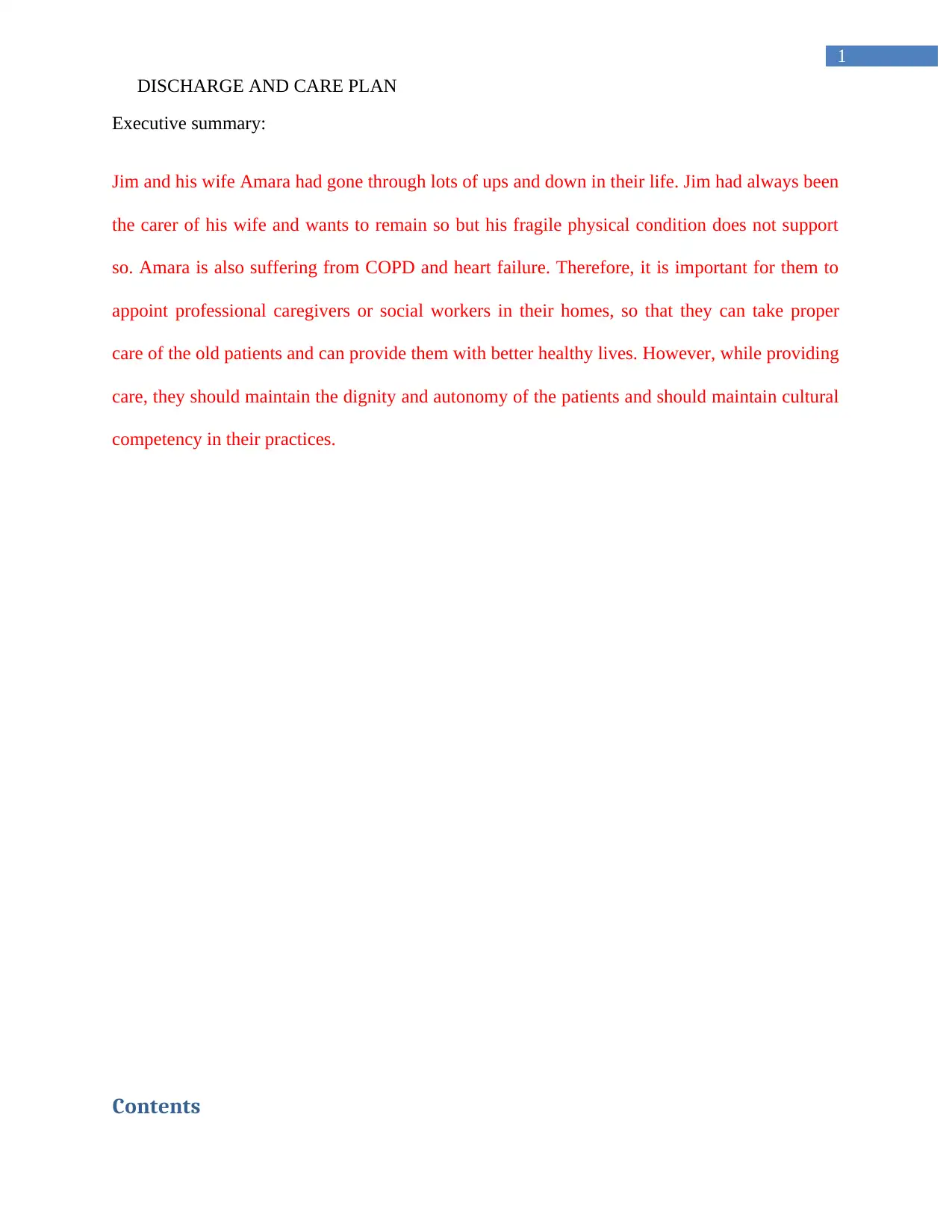
1
DISCHARGE AND CARE PLAN
Executive summary:
Jim and his wife Amara had gone through lots of ups and down in their life. Jim had always been
the carer of his wife and wants to remain so but his fragile physical condition does not support
so. Amara is also suffering from COPD and heart failure. Therefore, it is important for them to
appoint professional caregivers or social workers in their homes, so that they can take proper
care of the old patients and can provide them with better healthy lives. However, while providing
care, they should maintain the dignity and autonomy of the patients and should maintain cultural
competency in their practices.
Contents
DISCHARGE AND CARE PLAN
Executive summary:
Jim and his wife Amara had gone through lots of ups and down in their life. Jim had always been
the carer of his wife and wants to remain so but his fragile physical condition does not support
so. Amara is also suffering from COPD and heart failure. Therefore, it is important for them to
appoint professional caregivers or social workers in their homes, so that they can take proper
care of the old patients and can provide them with better healthy lives. However, while providing
care, they should maintain the dignity and autonomy of the patients and should maintain cultural
competency in their practices.
Contents
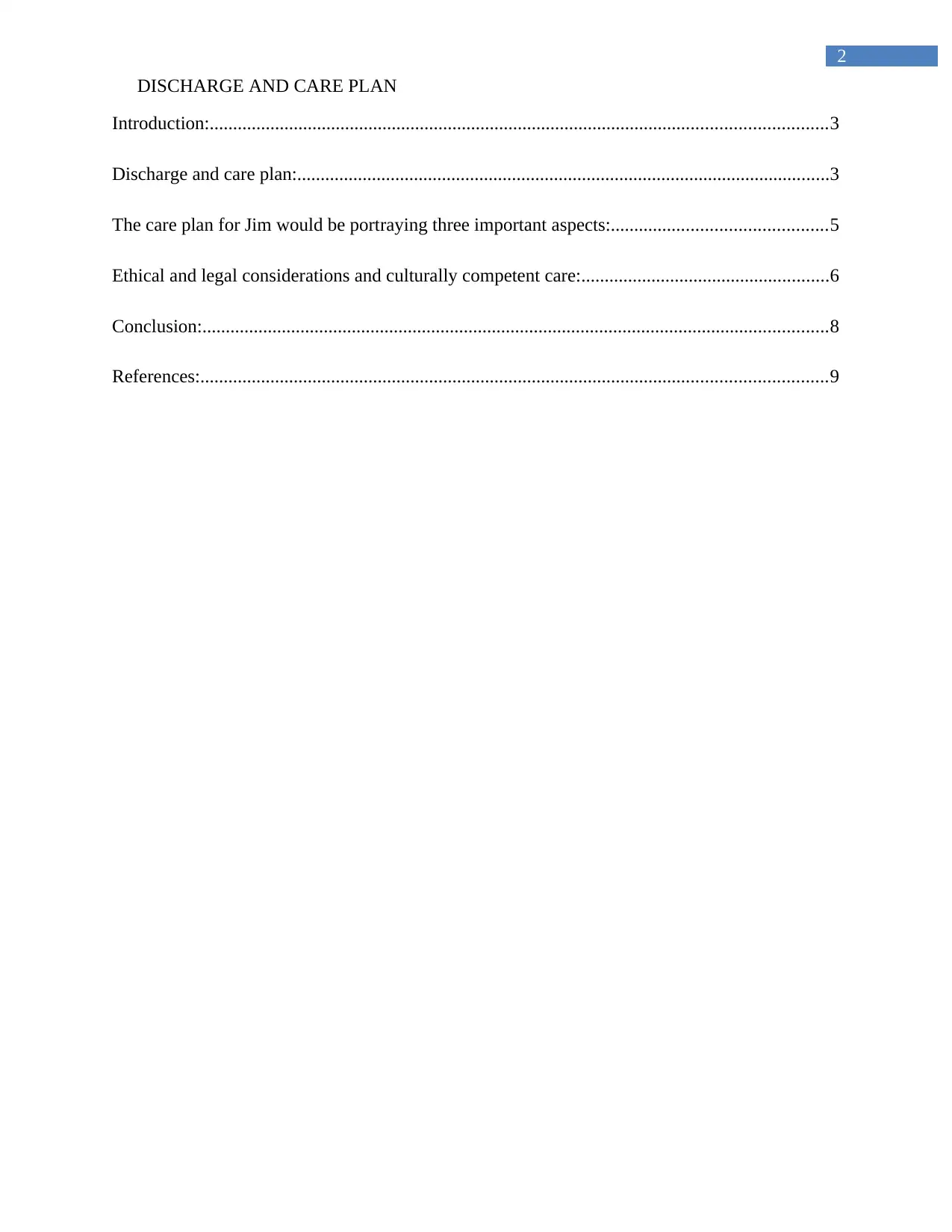
2
DISCHARGE AND CARE PLAN
Introduction:....................................................................................................................................3
Discharge and care plan:..................................................................................................................3
The care plan for Jim would be portraying three important aspects:..............................................5
Ethical and legal considerations and culturally competent care:.....................................................6
Conclusion:......................................................................................................................................8
References:......................................................................................................................................9
DISCHARGE AND CARE PLAN
Introduction:....................................................................................................................................3
Discharge and care plan:..................................................................................................................3
The care plan for Jim would be portraying three important aspects:..............................................5
Ethical and legal considerations and culturally competent care:.....................................................6
Conclusion:......................................................................................................................................8
References:......................................................................................................................................9
⊘ This is a preview!⊘
Do you want full access?
Subscribe today to unlock all pages.

Trusted by 1+ million students worldwide
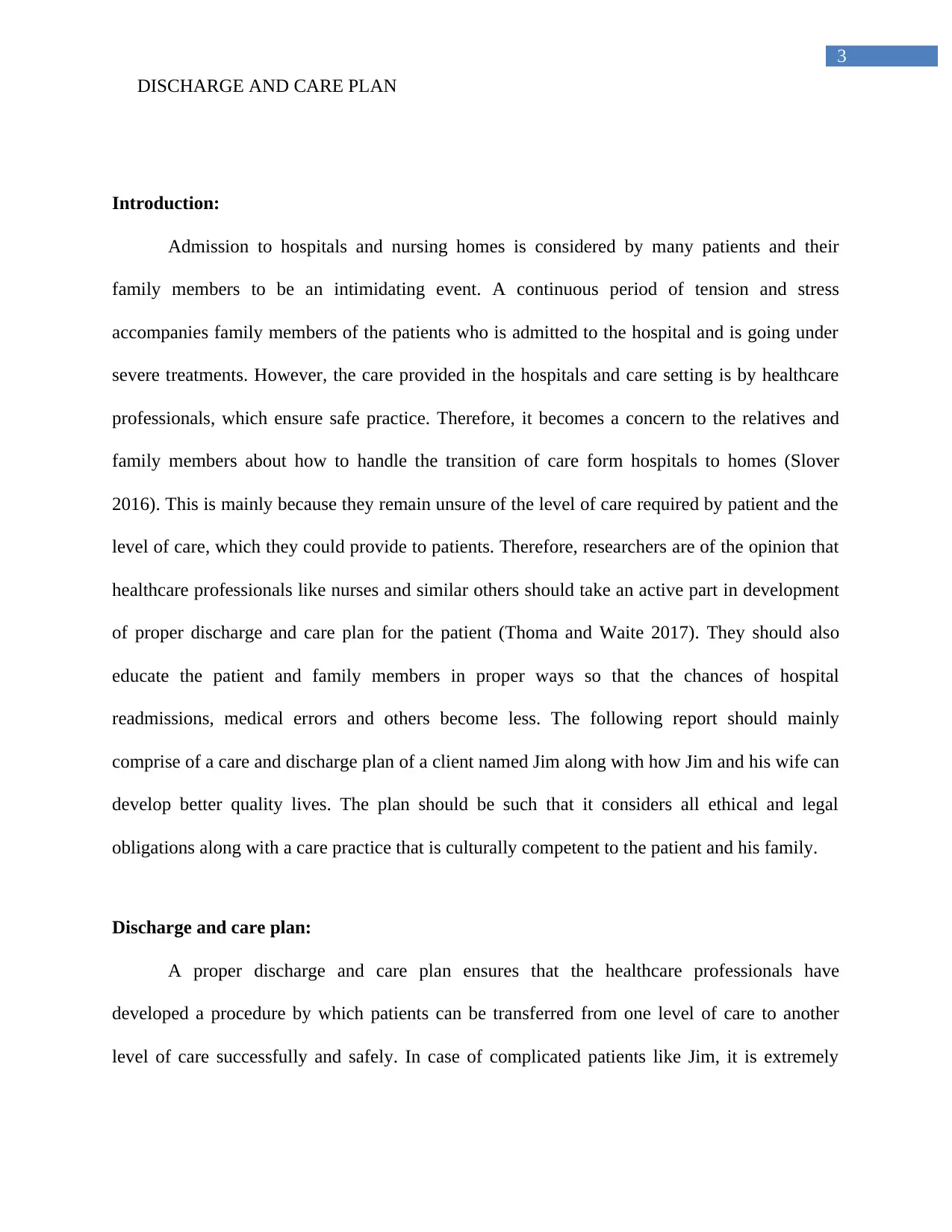
3
DISCHARGE AND CARE PLAN
Introduction:
Admission to hospitals and nursing homes is considered by many patients and their
family members to be an intimidating event. A continuous period of tension and stress
accompanies family members of the patients who is admitted to the hospital and is going under
severe treatments. However, the care provided in the hospitals and care setting is by healthcare
professionals, which ensure safe practice. Therefore, it becomes a concern to the relatives and
family members about how to handle the transition of care form hospitals to homes (Slover
2016). This is mainly because they remain unsure of the level of care required by patient and the
level of care, which they could provide to patients. Therefore, researchers are of the opinion that
healthcare professionals like nurses and similar others should take an active part in development
of proper discharge and care plan for the patient (Thoma and Waite 2017). They should also
educate the patient and family members in proper ways so that the chances of hospital
readmissions, medical errors and others become less. The following report should mainly
comprise of a care and discharge plan of a client named Jim along with how Jim and his wife can
develop better quality lives. The plan should be such that it considers all ethical and legal
obligations along with a care practice that is culturally competent to the patient and his family.
Discharge and care plan:
A proper discharge and care plan ensures that the healthcare professionals have
developed a procedure by which patients can be transferred from one level of care to another
level of care successfully and safely. In case of complicated patients like Jim, it is extremely
DISCHARGE AND CARE PLAN
Introduction:
Admission to hospitals and nursing homes is considered by many patients and their
family members to be an intimidating event. A continuous period of tension and stress
accompanies family members of the patients who is admitted to the hospital and is going under
severe treatments. However, the care provided in the hospitals and care setting is by healthcare
professionals, which ensure safe practice. Therefore, it becomes a concern to the relatives and
family members about how to handle the transition of care form hospitals to homes (Slover
2016). This is mainly because they remain unsure of the level of care required by patient and the
level of care, which they could provide to patients. Therefore, researchers are of the opinion that
healthcare professionals like nurses and similar others should take an active part in development
of proper discharge and care plan for the patient (Thoma and Waite 2017). They should also
educate the patient and family members in proper ways so that the chances of hospital
readmissions, medical errors and others become less. The following report should mainly
comprise of a care and discharge plan of a client named Jim along with how Jim and his wife can
develop better quality lives. The plan should be such that it considers all ethical and legal
obligations along with a care practice that is culturally competent to the patient and his family.
Discharge and care plan:
A proper discharge and care plan ensures that the healthcare professionals have
developed a procedure by which patients can be transferred from one level of care to another
level of care successfully and safely. In case of complicated patients like Jim, it is extremely
Paraphrase This Document
Need a fresh take? Get an instant paraphrase of this document with our AI Paraphraser
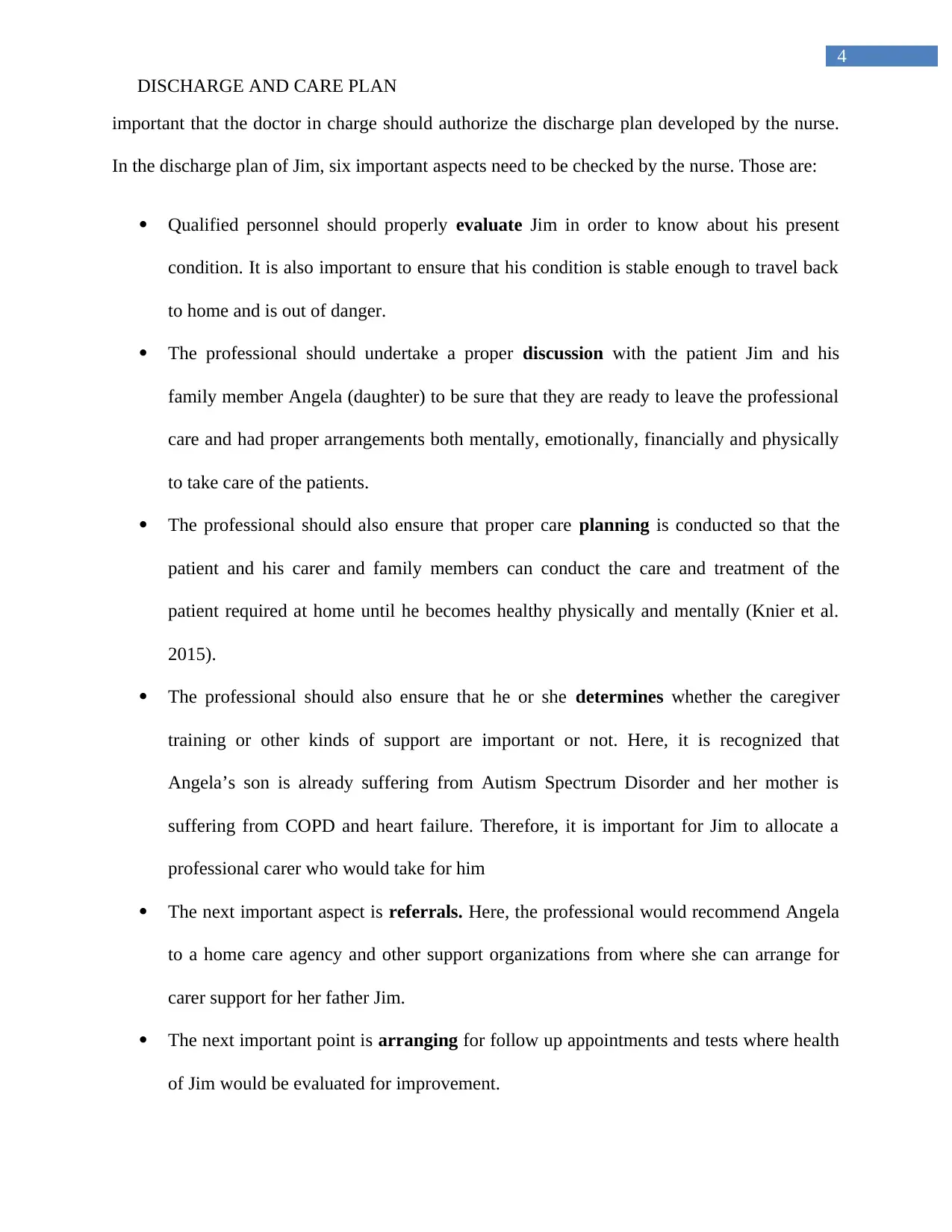
4
DISCHARGE AND CARE PLAN
important that the doctor in charge should authorize the discharge plan developed by the nurse.
In the discharge plan of Jim, six important aspects need to be checked by the nurse. Those are:
Qualified personnel should properly evaluate Jim in order to know about his present
condition. It is also important to ensure that his condition is stable enough to travel back
to home and is out of danger.
The professional should undertake a proper discussion with the patient Jim and his
family member Angela (daughter) to be sure that they are ready to leave the professional
care and had proper arrangements both mentally, emotionally, financially and physically
to take care of the patients.
The professional should also ensure that proper care planning is conducted so that the
patient and his carer and family members can conduct the care and treatment of the
patient required at home until he becomes healthy physically and mentally (Knier et al.
2015).
The professional should also ensure that he or she determines whether the caregiver
training or other kinds of support are important or not. Here, it is recognized that
Angela’s son is already suffering from Autism Spectrum Disorder and her mother is
suffering from COPD and heart failure. Therefore, it is important for Jim to allocate a
professional carer who would take for him
The next important aspect is referrals. Here, the professional would recommend Angela
to a home care agency and other support organizations from where she can arrange for
carer support for her father Jim.
The next important point is arranging for follow up appointments and tests where health
of Jim would be evaluated for improvement.
DISCHARGE AND CARE PLAN
important that the doctor in charge should authorize the discharge plan developed by the nurse.
In the discharge plan of Jim, six important aspects need to be checked by the nurse. Those are:
Qualified personnel should properly evaluate Jim in order to know about his present
condition. It is also important to ensure that his condition is stable enough to travel back
to home and is out of danger.
The professional should undertake a proper discussion with the patient Jim and his
family member Angela (daughter) to be sure that they are ready to leave the professional
care and had proper arrangements both mentally, emotionally, financially and physically
to take care of the patients.
The professional should also ensure that proper care planning is conducted so that the
patient and his carer and family members can conduct the care and treatment of the
patient required at home until he becomes healthy physically and mentally (Knier et al.
2015).
The professional should also ensure that he or she determines whether the caregiver
training or other kinds of support are important or not. Here, it is recognized that
Angela’s son is already suffering from Autism Spectrum Disorder and her mother is
suffering from COPD and heart failure. Therefore, it is important for Jim to allocate a
professional carer who would take for him
The next important aspect is referrals. Here, the professional would recommend Angela
to a home care agency and other support organizations from where she can arrange for
carer support for her father Jim.
The next important point is arranging for follow up appointments and tests where health
of Jim would be evaluated for improvement.
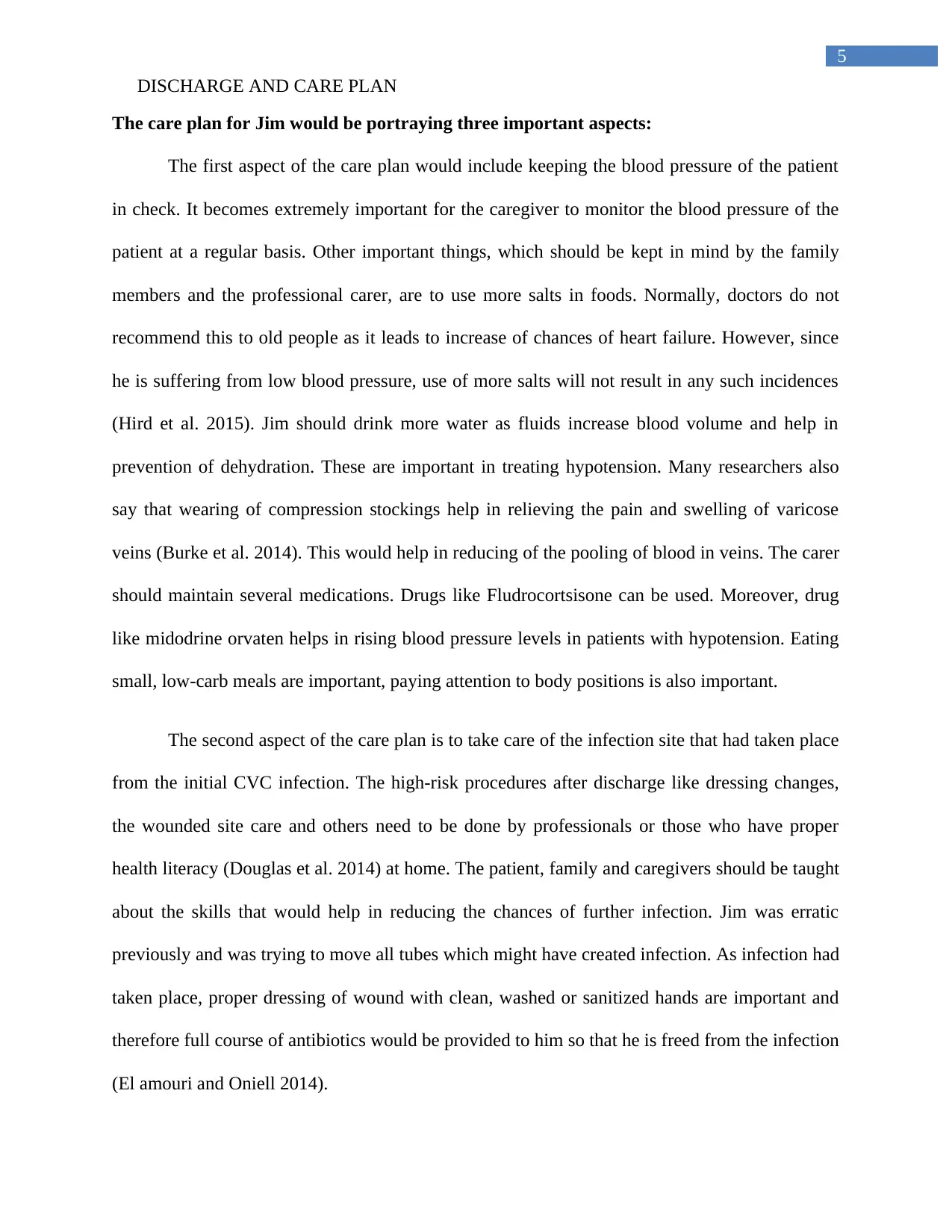
5
DISCHARGE AND CARE PLAN
The care plan for Jim would be portraying three important aspects:
The first aspect of the care plan would include keeping the blood pressure of the patient
in check. It becomes extremely important for the caregiver to monitor the blood pressure of the
patient at a regular basis. Other important things, which should be kept in mind by the family
members and the professional carer, are to use more salts in foods. Normally, doctors do not
recommend this to old people as it leads to increase of chances of heart failure. However, since
he is suffering from low blood pressure, use of more salts will not result in any such incidences
(Hird et al. 2015). Jim should drink more water as fluids increase blood volume and help in
prevention of dehydration. These are important in treating hypotension. Many researchers also
say that wearing of compression stockings help in relieving the pain and swelling of varicose
veins (Burke et al. 2014). This would help in reducing of the pooling of blood in veins. The carer
should maintain several medications. Drugs like Fludrocortsisone can be used. Moreover, drug
like midodrine orvaten helps in rising blood pressure levels in patients with hypotension. Eating
small, low-carb meals are important, paying attention to body positions is also important.
The second aspect of the care plan is to take care of the infection site that had taken place
from the initial CVC infection. The high-risk procedures after discharge like dressing changes,
the wounded site care and others need to be done by professionals or those who have proper
health literacy (Douglas et al. 2014) at home. The patient, family and caregivers should be taught
about the skills that would help in reducing the chances of further infection. Jim was erratic
previously and was trying to move all tubes which might have created infection. As infection had
taken place, proper dressing of wound with clean, washed or sanitized hands are important and
therefore full course of antibiotics would be provided to him so that he is freed from the infection
(El amouri and Oniell 2014).
DISCHARGE AND CARE PLAN
The care plan for Jim would be portraying three important aspects:
The first aspect of the care plan would include keeping the blood pressure of the patient
in check. It becomes extremely important for the caregiver to monitor the blood pressure of the
patient at a regular basis. Other important things, which should be kept in mind by the family
members and the professional carer, are to use more salts in foods. Normally, doctors do not
recommend this to old people as it leads to increase of chances of heart failure. However, since
he is suffering from low blood pressure, use of more salts will not result in any such incidences
(Hird et al. 2015). Jim should drink more water as fluids increase blood volume and help in
prevention of dehydration. These are important in treating hypotension. Many researchers also
say that wearing of compression stockings help in relieving the pain and swelling of varicose
veins (Burke et al. 2014). This would help in reducing of the pooling of blood in veins. The carer
should maintain several medications. Drugs like Fludrocortsisone can be used. Moreover, drug
like midodrine orvaten helps in rising blood pressure levels in patients with hypotension. Eating
small, low-carb meals are important, paying attention to body positions is also important.
The second aspect of the care plan is to take care of the infection site that had taken place
from the initial CVC infection. The high-risk procedures after discharge like dressing changes,
the wounded site care and others need to be done by professionals or those who have proper
health literacy (Douglas et al. 2014) at home. The patient, family and caregivers should be taught
about the skills that would help in reducing the chances of further infection. Jim was erratic
previously and was trying to move all tubes which might have created infection. As infection had
taken place, proper dressing of wound with clean, washed or sanitized hands are important and
therefore full course of antibiotics would be provided to him so that he is freed from the infection
(El amouri and Oniell 2014).
⊘ This is a preview!⊘
Do you want full access?
Subscribe today to unlock all pages.

Trusted by 1+ million students worldwide
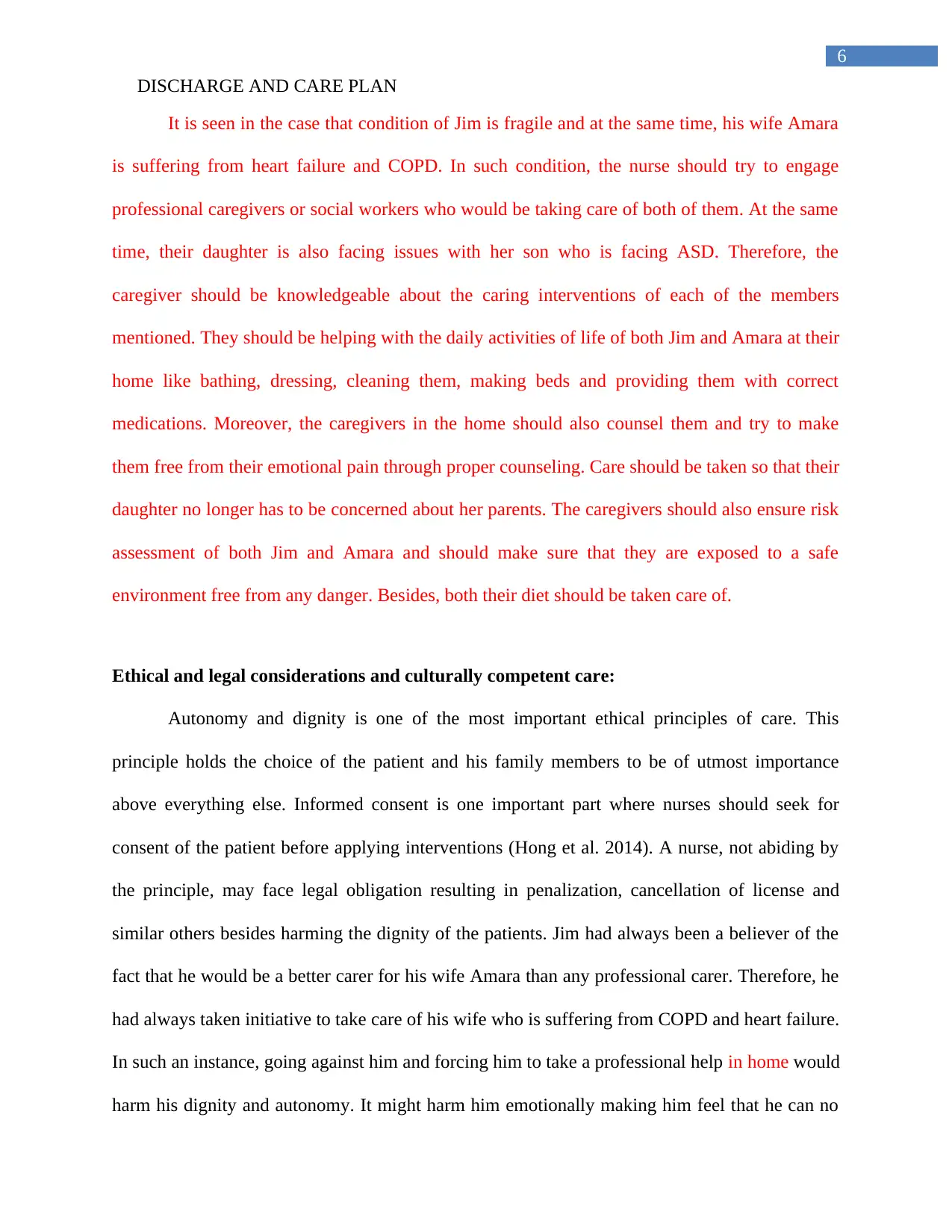
6
DISCHARGE AND CARE PLAN
It is seen in the case that condition of Jim is fragile and at the same time, his wife Amara
is suffering from heart failure and COPD. In such condition, the nurse should try to engage
professional caregivers or social workers who would be taking care of both of them. At the same
time, their daughter is also facing issues with her son who is facing ASD. Therefore, the
caregiver should be knowledgeable about the caring interventions of each of the members
mentioned. They should be helping with the daily activities of life of both Jim and Amara at their
home like bathing, dressing, cleaning them, making beds and providing them with correct
medications. Moreover, the caregivers in the home should also counsel them and try to make
them free from their emotional pain through proper counseling. Care should be taken so that their
daughter no longer has to be concerned about her parents. The caregivers should also ensure risk
assessment of both Jim and Amara and should make sure that they are exposed to a safe
environment free from any danger. Besides, both their diet should be taken care of.
Ethical and legal considerations and culturally competent care:
Autonomy and dignity is one of the most important ethical principles of care. This
principle holds the choice of the patient and his family members to be of utmost importance
above everything else. Informed consent is one important part where nurses should seek for
consent of the patient before applying interventions (Hong et al. 2014). A nurse, not abiding by
the principle, may face legal obligation resulting in penalization, cancellation of license and
similar others besides harming the dignity of the patients. Jim had always been a believer of the
fact that he would be a better carer for his wife Amara than any professional carer. Therefore, he
had always taken initiative to take care of his wife who is suffering from COPD and heart failure.
In such an instance, going against him and forcing him to take a professional help in home would
harm his dignity and autonomy. It might harm him emotionally making him feel that he can no
DISCHARGE AND CARE PLAN
It is seen in the case that condition of Jim is fragile and at the same time, his wife Amara
is suffering from heart failure and COPD. In such condition, the nurse should try to engage
professional caregivers or social workers who would be taking care of both of them. At the same
time, their daughter is also facing issues with her son who is facing ASD. Therefore, the
caregiver should be knowledgeable about the caring interventions of each of the members
mentioned. They should be helping with the daily activities of life of both Jim and Amara at their
home like bathing, dressing, cleaning them, making beds and providing them with correct
medications. Moreover, the caregivers in the home should also counsel them and try to make
them free from their emotional pain through proper counseling. Care should be taken so that their
daughter no longer has to be concerned about her parents. The caregivers should also ensure risk
assessment of both Jim and Amara and should make sure that they are exposed to a safe
environment free from any danger. Besides, both their diet should be taken care of.
Ethical and legal considerations and culturally competent care:
Autonomy and dignity is one of the most important ethical principles of care. This
principle holds the choice of the patient and his family members to be of utmost importance
above everything else. Informed consent is one important part where nurses should seek for
consent of the patient before applying interventions (Hong et al. 2014). A nurse, not abiding by
the principle, may face legal obligation resulting in penalization, cancellation of license and
similar others besides harming the dignity of the patients. Jim had always been a believer of the
fact that he would be a better carer for his wife Amara than any professional carer. Therefore, he
had always taken initiative to take care of his wife who is suffering from COPD and heart failure.
In such an instance, going against him and forcing him to take a professional help in home would
harm his dignity and autonomy. It might harm him emotionally making him feel that he can no
Paraphrase This Document
Need a fresh take? Get an instant paraphrase of this document with our AI Paraphraser
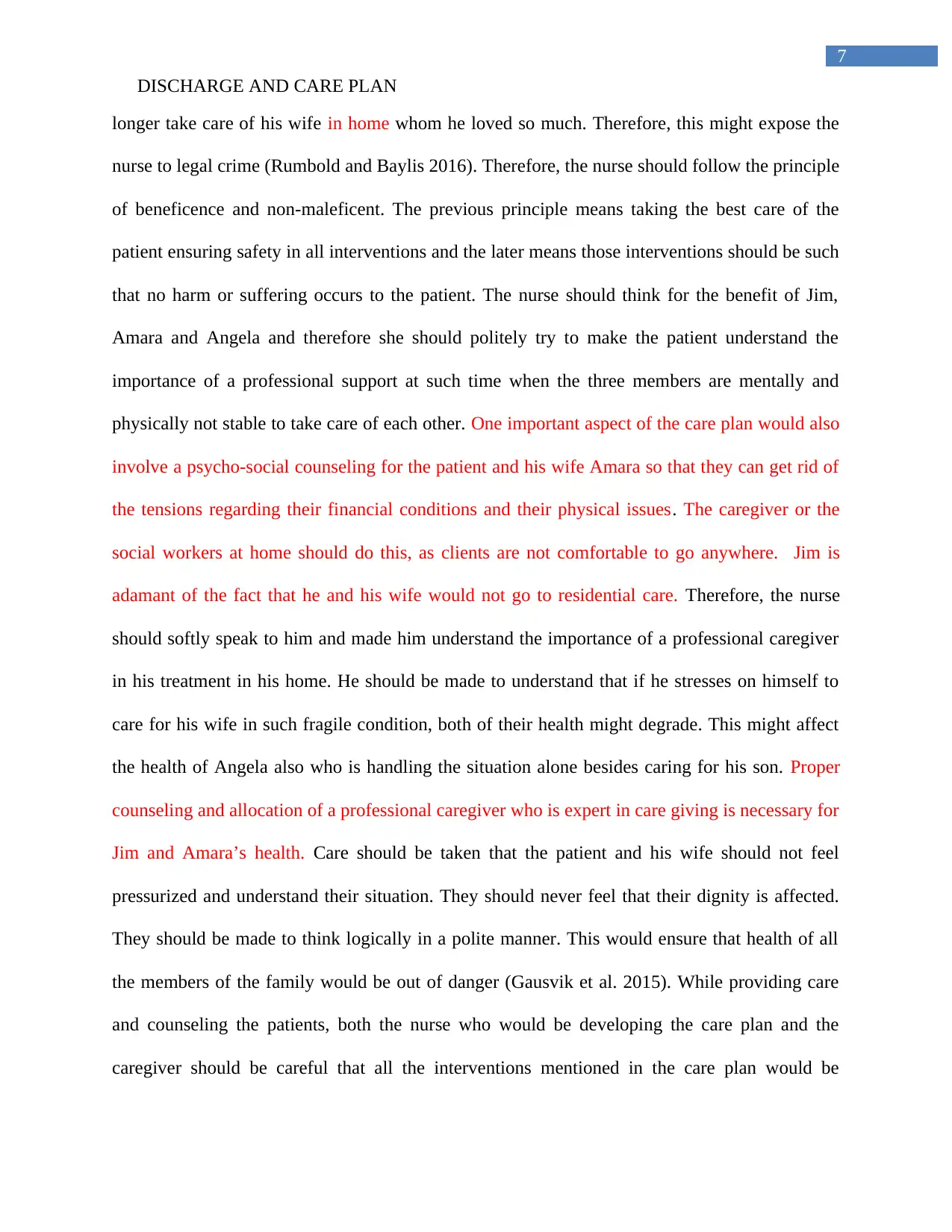
7
DISCHARGE AND CARE PLAN
longer take care of his wife in home whom he loved so much. Therefore, this might expose the
nurse to legal crime (Rumbold and Baylis 2016). Therefore, the nurse should follow the principle
of beneficence and non-maleficent. The previous principle means taking the best care of the
patient ensuring safety in all interventions and the later means those interventions should be such
that no harm or suffering occurs to the patient. The nurse should think for the benefit of Jim,
Amara and Angela and therefore she should politely try to make the patient understand the
importance of a professional support at such time when the three members are mentally and
physically not stable to take care of each other. One important aspect of the care plan would also
involve a psycho-social counseling for the patient and his wife Amara so that they can get rid of
the tensions regarding their financial conditions and their physical issues. The caregiver or the
social workers at home should do this, as clients are not comfortable to go anywhere. Jim is
adamant of the fact that he and his wife would not go to residential care. Therefore, the nurse
should softly speak to him and made him understand the importance of a professional caregiver
in his treatment in his home. He should be made to understand that if he stresses on himself to
care for his wife in such fragile condition, both of their health might degrade. This might affect
the health of Angela also who is handling the situation alone besides caring for his son. Proper
counseling and allocation of a professional caregiver who is expert in care giving is necessary for
Jim and Amara’s health. Care should be taken that the patient and his wife should not feel
pressurized and understand their situation. They should never feel that their dignity is affected.
They should be made to think logically in a polite manner. This would ensure that health of all
the members of the family would be out of danger (Gausvik et al. 2015). While providing care
and counseling the patients, both the nurse who would be developing the care plan and the
caregiver should be careful that all the interventions mentioned in the care plan would be
DISCHARGE AND CARE PLAN
longer take care of his wife in home whom he loved so much. Therefore, this might expose the
nurse to legal crime (Rumbold and Baylis 2016). Therefore, the nurse should follow the principle
of beneficence and non-maleficent. The previous principle means taking the best care of the
patient ensuring safety in all interventions and the later means those interventions should be such
that no harm or suffering occurs to the patient. The nurse should think for the benefit of Jim,
Amara and Angela and therefore she should politely try to make the patient understand the
importance of a professional support at such time when the three members are mentally and
physically not stable to take care of each other. One important aspect of the care plan would also
involve a psycho-social counseling for the patient and his wife Amara so that they can get rid of
the tensions regarding their financial conditions and their physical issues. The caregiver or the
social workers at home should do this, as clients are not comfortable to go anywhere. Jim is
adamant of the fact that he and his wife would not go to residential care. Therefore, the nurse
should softly speak to him and made him understand the importance of a professional caregiver
in his treatment in his home. He should be made to understand that if he stresses on himself to
care for his wife in such fragile condition, both of their health might degrade. This might affect
the health of Angela also who is handling the situation alone besides caring for his son. Proper
counseling and allocation of a professional caregiver who is expert in care giving is necessary for
Jim and Amara’s health. Care should be taken that the patient and his wife should not feel
pressurized and understand their situation. They should never feel that their dignity is affected.
They should be made to think logically in a polite manner. This would ensure that health of all
the members of the family would be out of danger (Gausvik et al. 2015). While providing care
and counseling the patients, both the nurse who would be developing the care plan and the
caregiver should be careful that all the interventions mentioned in the care plan would be
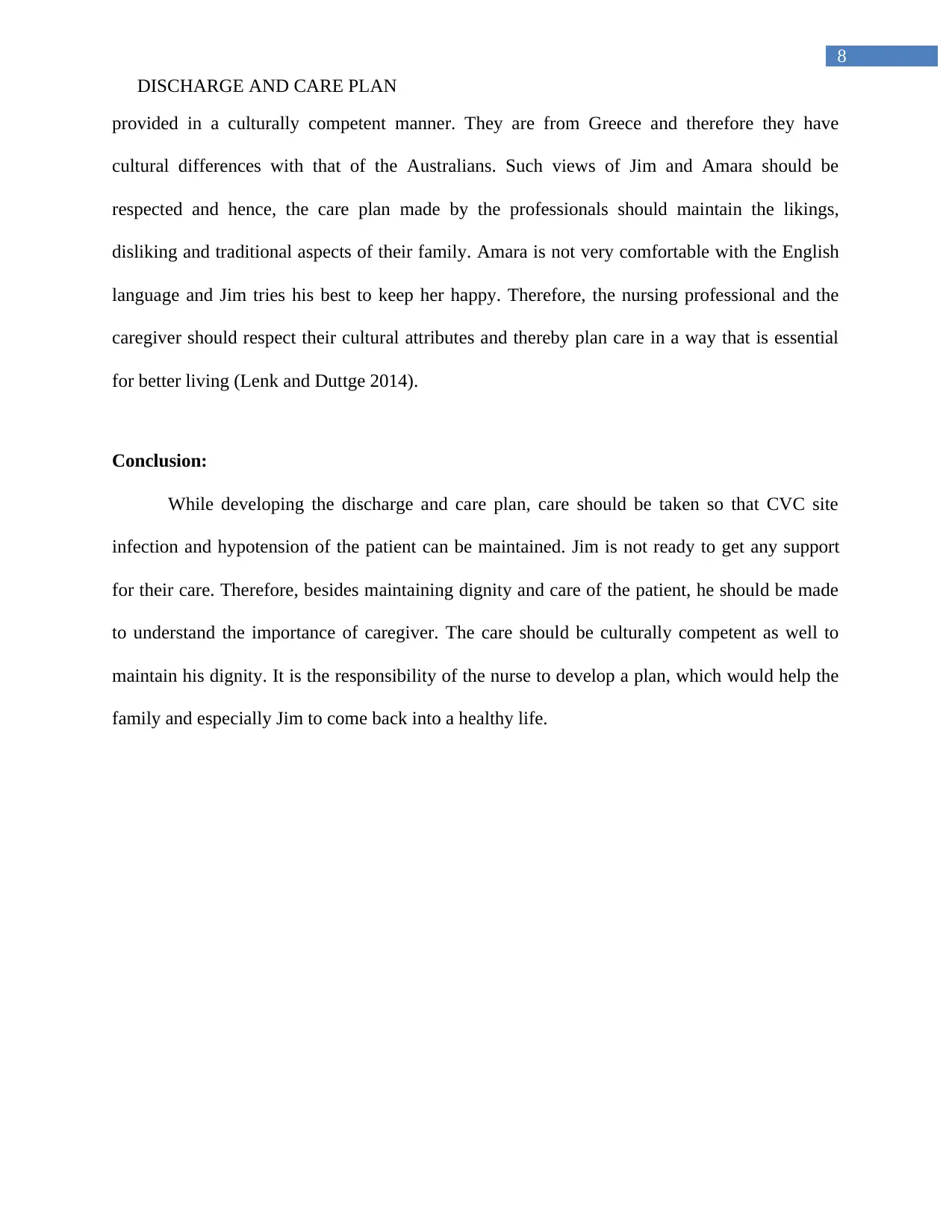
8
DISCHARGE AND CARE PLAN
provided in a culturally competent manner. They are from Greece and therefore they have
cultural differences with that of the Australians. Such views of Jim and Amara should be
respected and hence, the care plan made by the professionals should maintain the likings,
disliking and traditional aspects of their family. Amara is not very comfortable with the English
language and Jim tries his best to keep her happy. Therefore, the nursing professional and the
caregiver should respect their cultural attributes and thereby plan care in a way that is essential
for better living (Lenk and Duttge 2014).
Conclusion:
While developing the discharge and care plan, care should be taken so that CVC site
infection and hypotension of the patient can be maintained. Jim is not ready to get any support
for their care. Therefore, besides maintaining dignity and care of the patient, he should be made
to understand the importance of caregiver. The care should be culturally competent as well to
maintain his dignity. It is the responsibility of the nurse to develop a plan, which would help the
family and especially Jim to come back into a healthy life.
DISCHARGE AND CARE PLAN
provided in a culturally competent manner. They are from Greece and therefore they have
cultural differences with that of the Australians. Such views of Jim and Amara should be
respected and hence, the care plan made by the professionals should maintain the likings,
disliking and traditional aspects of their family. Amara is not very comfortable with the English
language and Jim tries his best to keep her happy. Therefore, the nursing professional and the
caregiver should respect their cultural attributes and thereby plan care in a way that is essential
for better living (Lenk and Duttge 2014).
Conclusion:
While developing the discharge and care plan, care should be taken so that CVC site
infection and hypotension of the patient can be maintained. Jim is not ready to get any support
for their care. Therefore, besides maintaining dignity and care of the patient, he should be made
to understand the importance of caregiver. The care should be culturally competent as well to
maintain his dignity. It is the responsibility of the nurse to develop a plan, which would help the
family and especially Jim to come back into a healthy life.
⊘ This is a preview!⊘
Do you want full access?
Subscribe today to unlock all pages.

Trusted by 1+ million students worldwide
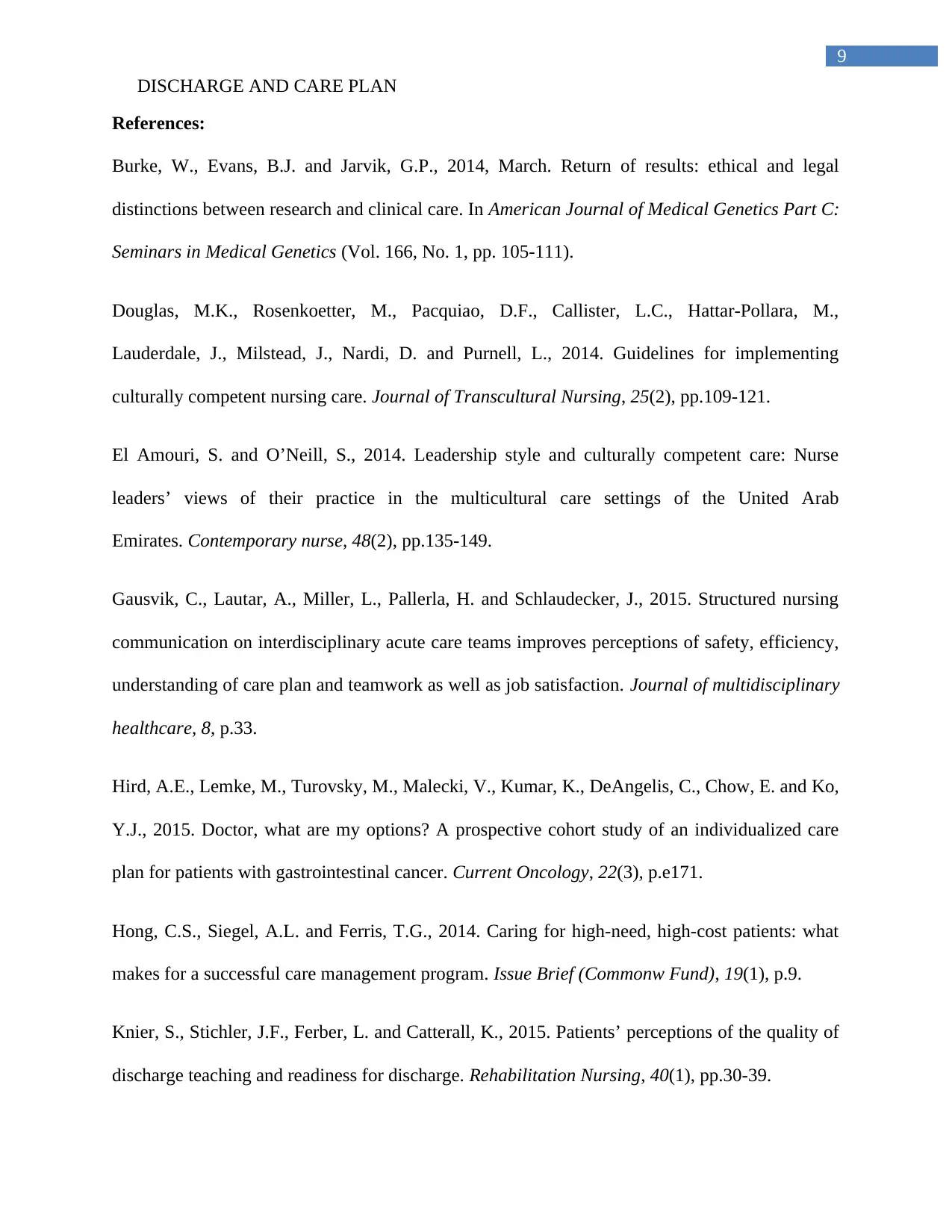
9
DISCHARGE AND CARE PLAN
References:
Burke, W., Evans, B.J. and Jarvik, G.P., 2014, March. Return of results: ethical and legal
distinctions between research and clinical care. In American Journal of Medical Genetics Part C:
Seminars in Medical Genetics (Vol. 166, No. 1, pp. 105-111).
Douglas, M.K., Rosenkoetter, M., Pacquiao, D.F., Callister, L.C., Hattar-Pollara, M.,
Lauderdale, J., Milstead, J., Nardi, D. and Purnell, L., 2014. Guidelines for implementing
culturally competent nursing care. Journal of Transcultural Nursing, 25(2), pp.109-121.
El Amouri, S. and O’Neill, S., 2014. Leadership style and culturally competent care: Nurse
leaders’ views of their practice in the multicultural care settings of the United Arab
Emirates. Contemporary nurse, 48(2), pp.135-149.
Gausvik, C., Lautar, A., Miller, L., Pallerla, H. and Schlaudecker, J., 2015. Structured nursing
communication on interdisciplinary acute care teams improves perceptions of safety, efficiency,
understanding of care plan and teamwork as well as job satisfaction. Journal of multidisciplinary
healthcare, 8, p.33.
Hird, A.E., Lemke, M., Turovsky, M., Malecki, V., Kumar, K., DeAngelis, C., Chow, E. and Ko,
Y.J., 2015. Doctor, what are my options? A prospective cohort study of an individualized care
plan for patients with gastrointestinal cancer. Current Oncology, 22(3), p.e171.
Hong, C.S., Siegel, A.L. and Ferris, T.G., 2014. Caring for high-need, high-cost patients: what
makes for a successful care management program. Issue Brief (Commonw Fund), 19(1), p.9.
Knier, S., Stichler, J.F., Ferber, L. and Catterall, K., 2015. Patients’ perceptions of the quality of
discharge teaching and readiness for discharge. Rehabilitation Nursing, 40(1), pp.30-39.
DISCHARGE AND CARE PLAN
References:
Burke, W., Evans, B.J. and Jarvik, G.P., 2014, March. Return of results: ethical and legal
distinctions between research and clinical care. In American Journal of Medical Genetics Part C:
Seminars in Medical Genetics (Vol. 166, No. 1, pp. 105-111).
Douglas, M.K., Rosenkoetter, M., Pacquiao, D.F., Callister, L.C., Hattar-Pollara, M.,
Lauderdale, J., Milstead, J., Nardi, D. and Purnell, L., 2014. Guidelines for implementing
culturally competent nursing care. Journal of Transcultural Nursing, 25(2), pp.109-121.
El Amouri, S. and O’Neill, S., 2014. Leadership style and culturally competent care: Nurse
leaders’ views of their practice in the multicultural care settings of the United Arab
Emirates. Contemporary nurse, 48(2), pp.135-149.
Gausvik, C., Lautar, A., Miller, L., Pallerla, H. and Schlaudecker, J., 2015. Structured nursing
communication on interdisciplinary acute care teams improves perceptions of safety, efficiency,
understanding of care plan and teamwork as well as job satisfaction. Journal of multidisciplinary
healthcare, 8, p.33.
Hird, A.E., Lemke, M., Turovsky, M., Malecki, V., Kumar, K., DeAngelis, C., Chow, E. and Ko,
Y.J., 2015. Doctor, what are my options? A prospective cohort study of an individualized care
plan for patients with gastrointestinal cancer. Current Oncology, 22(3), p.e171.
Hong, C.S., Siegel, A.L. and Ferris, T.G., 2014. Caring for high-need, high-cost patients: what
makes for a successful care management program. Issue Brief (Commonw Fund), 19(1), p.9.
Knier, S., Stichler, J.F., Ferber, L. and Catterall, K., 2015. Patients’ perceptions of the quality of
discharge teaching and readiness for discharge. Rehabilitation Nursing, 40(1), pp.30-39.
Paraphrase This Document
Need a fresh take? Get an instant paraphrase of this document with our AI Paraphraser
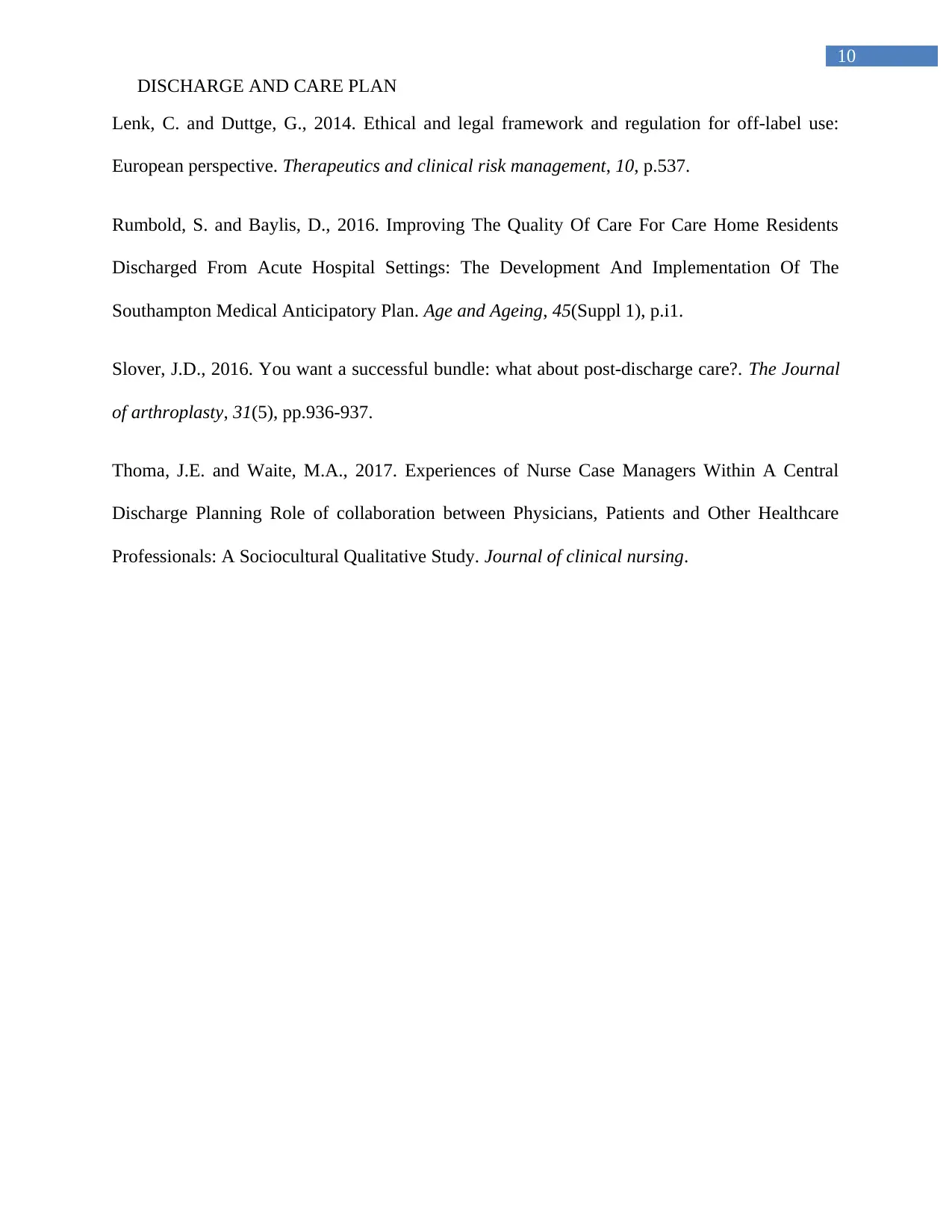
10
DISCHARGE AND CARE PLAN
Lenk, C. and Duttge, G., 2014. Ethical and legal framework and regulation for off-label use:
European perspective. Therapeutics and clinical risk management, 10, p.537.
Rumbold, S. and Baylis, D., 2016. Improving The Quality Of Care For Care Home Residents
Discharged From Acute Hospital Settings: The Development And Implementation Of The
Southampton Medical Anticipatory Plan. Age and Ageing, 45(Suppl 1), p.i1.
Slover, J.D., 2016. You want a successful bundle: what about post-discharge care?. The Journal
of arthroplasty, 31(5), pp.936-937.
Thoma, J.E. and Waite, M.A., 2017. Experiences of Nurse Case Managers Within A Central
Discharge Planning Role of collaboration between Physicians, Patients and Other Healthcare
Professionals: A Sociocultural Qualitative Study. Journal of clinical nursing.
DISCHARGE AND CARE PLAN
Lenk, C. and Duttge, G., 2014. Ethical and legal framework and regulation for off-label use:
European perspective. Therapeutics and clinical risk management, 10, p.537.
Rumbold, S. and Baylis, D., 2016. Improving The Quality Of Care For Care Home Residents
Discharged From Acute Hospital Settings: The Development And Implementation Of The
Southampton Medical Anticipatory Plan. Age and Ageing, 45(Suppl 1), p.i1.
Slover, J.D., 2016. You want a successful bundle: what about post-discharge care?. The Journal
of arthroplasty, 31(5), pp.936-937.
Thoma, J.E. and Waite, M.A., 2017. Experiences of Nurse Case Managers Within A Central
Discharge Planning Role of collaboration between Physicians, Patients and Other Healthcare
Professionals: A Sociocultural Qualitative Study. Journal of clinical nursing.
1 out of 11
Related Documents
Your All-in-One AI-Powered Toolkit for Academic Success.
+13062052269
info@desklib.com
Available 24*7 on WhatsApp / Email
![[object Object]](/_next/static/media/star-bottom.7253800d.svg)
Unlock your academic potential
Copyright © 2020–2025 A2Z Services. All Rights Reserved. Developed and managed by ZUCOL.





